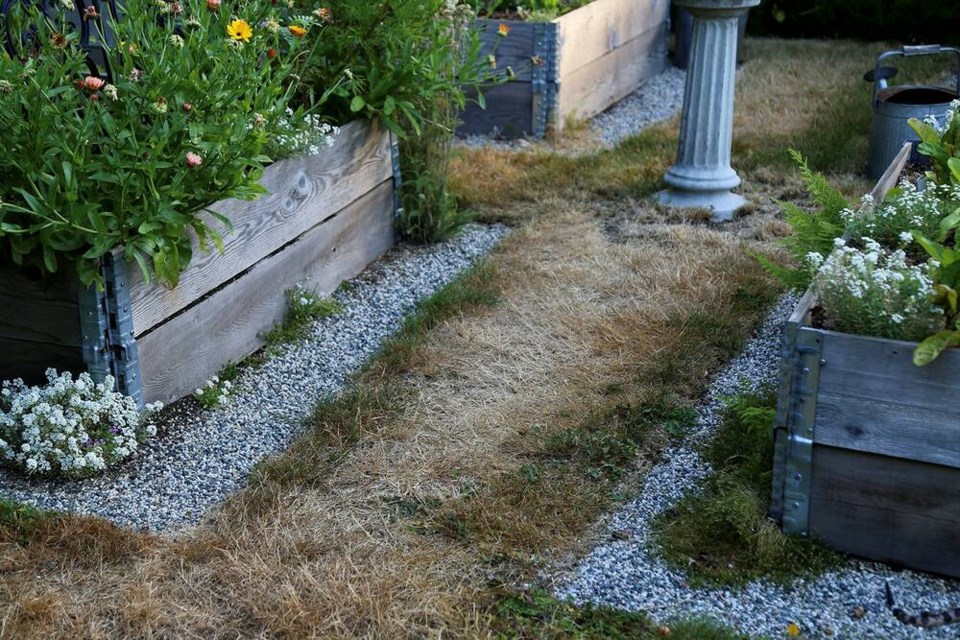Five years ago, we manually de-thatched our chafer beetle-ridden front lawn, top-dressed it with soil and over-seeded it with an alternative lawn blend developed by Westcoast Seeds in partnership with the City of Richmond. The so-called Bee Turf mixture of drought-tolerant grasses, herbs and flowers was designed to reduce maintenance costs and inputs significantly, and increase pollinator forage.
Admittedly, we didn’t do a proper job of it, primarily due to a pandemic-related shortage of seed and seed-starting soil, but also because we inadequately de-thatched the lawn, leaving more roots in-place than we knew.
Fast forward to today when, after many physical changes to the space but no over-seeding, we have alternating patches of lovely soft Bee Turf along the margins of what can only be described as an unsightly, crispy, dead moonscape of predatory invasive grass.
Here and there throughout the woefully downtrodden, bright green spots of wild strawberry, self-heal, oregano, creeping thyme, lemon balm, lavender, yarrow, ranunculus, and other drought-tolerant plants originating from all corners of our property have taken hold voluntarily, illustrating with fragrant enthusiasm why traditional monoculture lawns are an indulgent idea best left in the past.
Permaculture teaches us to above all things “observe and interact,” which is something I have done in abundance with respect to the increasingly inhospitable ground that we walk on.
So, with a nod to extreme weather and the unsung cultivated and naturalized herb lawns of the past, we have decided to give a site-specific, drought-resistant, pollinator-friendly, mycorrhizal fungi-regulated, mini food forest, alternative lawn a go – starting from scratch with a fresh deep bed of compost-rich sandy soil.
We realize going in that, the new living mulch “lawn” will be in a beautiful, albeit constant, state of change, and like all gardens, will self-prescribe more or less of this-or-that varietal, as available and evolving ecosystem services dictate. For a very short time after monthly mowings, the carpet will be more-or-less uniformly green.
At all other times during the growing season, starting in February, various shades of frilly, broadleaf, serrated, blade-like and glossy green leaves with be punctuated alternately and in symphony by pink, purple, orange, blue, mauve, yellow, peach, red and teal.
And so, into a bed of sandy nutrient-rich soil, we will rake a 80:20 blend of Bee Turf and Alternative Wildflower Blend, augmented with creeping wild thyme and wild beach strawberry. Some seed will germinate quickly, others not until spring, but we are confident that the ground beneath our feet next summer will be welcoming not only to us, but to the bees, butterflies, beetles, birds, biology and biota that connect all livings things above and below ground, and filter contaminated rainwater and runoff, holding it in-place within the landscape.
Based on observation, our new alternative lawn of natural fodder and food should thrive during the growing season, with minimal watering just once per week to keep vital biology alive within the soil matrix. The densely planted field of annual (self-seeding) and perennial herbs, grasses and flowers should, given such cramped quarters, grow to dwarf versions of themselves, as the volunteers do now – crowded as they are by the dormant lawn.
In adjacent berry, dwarf fruit tree and vegetable beds, where alternative lawn seed washes in, we will welcome (on an as-needed basis) beneficials like yarrow, English daisy, creeping thyme, self-heal and alyssum.
My clients who started from scratch with Bee Turf alternative lawns, are very happy with the results, and I am confident to advocate for wholesale adoption of lawn alternatives. I would even push for legislation, barring the installation of traditional residential lawn-scapes moving forward.
I will report back.
Laura Marie Neubert is a West Vancouver-based urban permaculture designer. Follow her on Instagram @upfrontandbeautiful, learn more about permaculture by visiting her Upfront & Beautiful website or email your questions to her here.
For a taste of permaculture, watch the video below:




